This web session lets you search the Library's catalog — which may include physically held items and/or represent a virtual catalog of relevant resources — in any of several ways. If the features have been implemented, this session lets you submit reference questions or requests associated with items you find in a catalog search. If implemented by this site, one or more RSS feed links may also be available.
Note: A fictitious collection, not the catalog that you are searching, is used in the sample searches/displayed items used throughout the online help system.
Searching and Browsing the Catalog
Quick Search
If you have a key word or several words in mind that represent your research question, get started with just a quick search.
- If your multiple words represent a phrase, use the default "match all" button option.
- If you have two or more words that are synonyms/related, set the "match any" button option.
To include plural and variant forms of the same word stem, use the * for wildcarding.

Click the Search button to execute the search and display the results in the default report format (see the Report Options section below).
- If implemented, the Search Google button can be used to have your formulation submitted to the www.google.com search engine for an Internet search.
- Use Clear to empty the search box and to enter a new search.
If your research requires a multifaceted search or you want to have more control over the number of retrieved items — to formulate a more precise search or to broaden the retrieval of candidate items of interest — consider using the Advanced Search page.
Browse Subjects
If you are uncertain of the most appropriate key words to use or would like to explore the contents of the Library collection, use this left-side link to review an alphabetical listing of subject terms that have been assigned by library staff to the catalog items.
When you click the link, the new page displays a part of the subject index, beginning with the A's. Page Up and Down or, alternatively, move directly to a particular part of the alphabetic listing by filling in the Show Term Near: box with a single character or with a partial or full word.
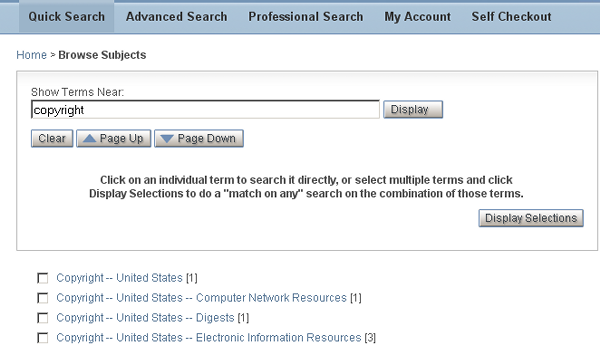
- Each individual term is a link that, when clicked, will execute a search. The number of items that your search will retrieve is shown in parentheses after the term.
- If you find multiple terms of interest, on one page or across several pages/multiple parts of the index, check each and then click Display Selections. Your terms will be ORed together in a "match any" search.
Alternatively, browsing these official search terms may provide inspiration for words you can use in formulating a Quick Search.
Access to this index of search terms — and to search terms from other fields, e.g., author names — is also available on the Advanced Search page, for pasting selected terms directly into a search line.
After your search is executed (and records have been retrieved), you are taken to the first of two types of report pages for online displays: the first, for browsing your search results and a second, for displaying more information about items of interest. On each page, with each report, you can also:
- Print/Save the current report (either as a text file or as a PDF) or Download full record data to your desktop in a comma-separated-values (.csv) file for use in Excel and other similar programs. If the email option has been set up on the Library's system, you can also Email the current report as an attachment.
- Select items of interest and re-display, print, or download just your selected list.
-
Submit a request for selected items or services related to those items.
As you navigate through the various report options, use the "breadcrumbs" below the tabs rather than the browser's back button, to return to an earlier page, so that the application can keep track of your steps.

Browse Reports
The "browse" page, with the default report for a Quick Search, looks like the one below.
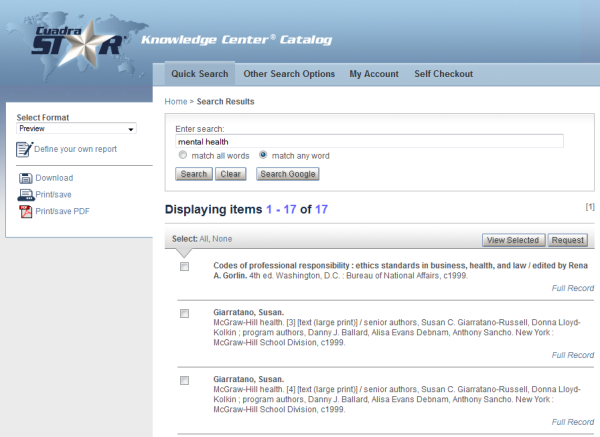
The default report displays the search results sorted by main entry.
After Browsing Your Results
At any time, on the Search Results (or Home) page, you can modify your search and, from the Browse report page, you also have these other options:
- For a given item of interest, click Full Record for more information and, on the "more" report page, use Next and Previous to move among items in your retrieved set.
-
To view your retrieved set in different sort orders (e.g., by subject or by author), open the Select Format listbox to change the display.
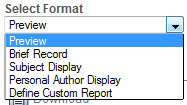
- [if implemented by the Library] To request items from the Library, make selections and click the Request button.
- When you are satisfied with your retrieved set, you have these other options: print/save the current report as a text file or PDF to a local printer or file, or download the full records to your desktop.
The "more report" page, with the default report for one of our sample searches looks like the page below. Use Next and Previous to move through your retrieved set of records.
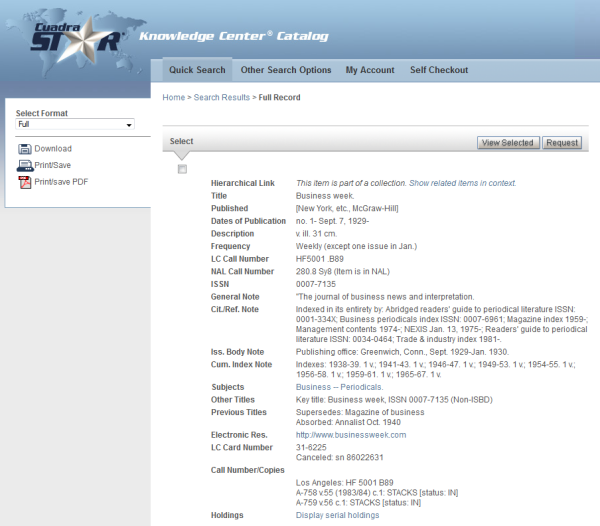
- If a particular author or subject is associated with more than the current record, the data are represented as links, so you can take a side-trip to retrieve a related set of records. These search links are not limited to your current retrieved set. The entire catalog is being searched.
-
If an item is linked to other records (e.g., if you have retrieved a journal record and there are several articles from that journal in the catalog), the "This item is part of a collection..." link is generated and use of the Show related items in context link will re-generate the record with its related items.
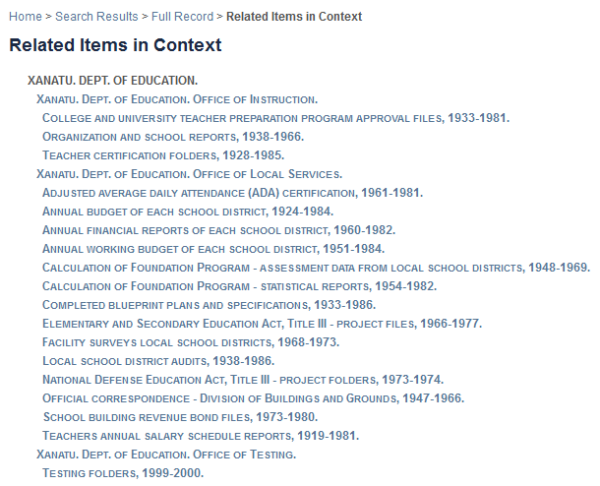
-
If you retrieve a journal, newsletter, continuing series, or other serial for which the library has an active subscription or issues from a previously active subscription, another link (see the Display serial holdings link below) will be generated so that you can display the Library's holdings.
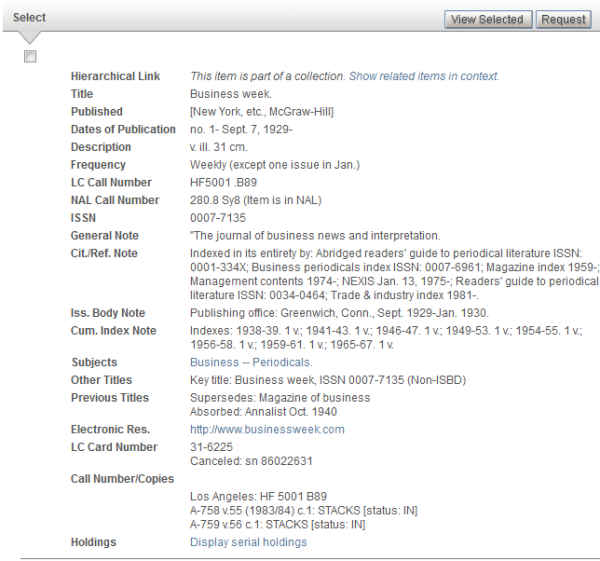
-
To print/save, or download from a More report page, click on the applicable left-side report link to open its menu and choose one of the options.
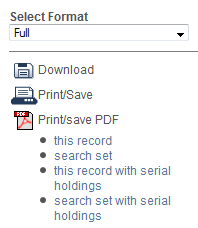
Using Other Features
Depending on how the system has been set up, you may have access to any one or more of these additional session features:
Left-side links:
Tabs:
| Advanced Search (separate page for multifaceted searching) Professional Search (expert advanced search page) My Account (service/status activity report; requires being a registered library user) |